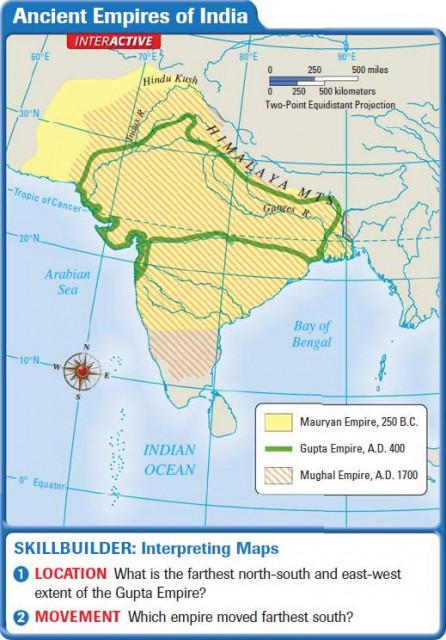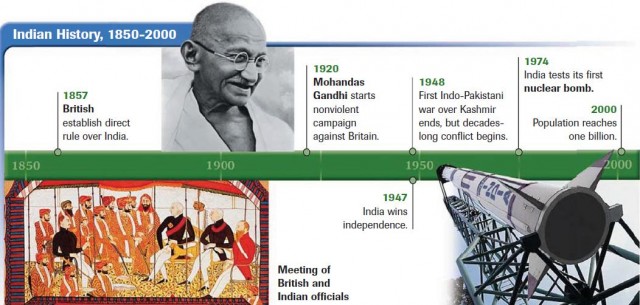South Asia: India
A HUMAN PERSPECTIVE At midnight on August 14, 1997, India celebrated the 50th anniversary of its independence from Great Britain. Thousands of people flooded the streets of the capital, New Delhi, and waved the orange, white, and green flag of India. Fifty years before, Prime Minister Jawaharlal Nehru had spoken to the nation. “A moment comes,” he said, “when we step out from the old to the new, . . . and when the soul of a nation, long suppressed, finds utterance [expression].” Since then, India has emerged as a modern and powerful country. But it has also preserved its links to the past.
Invasions, Empires, and Independence
India is an ancient land. Its culture and history date back more than 4,000 years. For centuries, foreign invaders came to conquer India but were absorbed into Indian life. As a result, Indian culture is a blend of many different customs and traditions.

EARLY HISTORY
Indian civilization began in the Indus Valley (now in Pakistan) around 2500 B.C. A thousand years later, invaders crossed the mountains of the Hindu Kush and spread across northern India. They were Aryans, a light-skinned people from the plains north of Iran. Aryan culture played a key role in the development of Indian civilization. The Aryans established small kingdoms on the Ganges Plain. They pushed darker-skinned, native Indians, called Dravidians, toward the south. Later, Persian and Greek invaders occupied the Indus Valley. But they did not conquer the Aryan kingdoms of the Ganges.
Two great Indian empires eventually emerged on the lower Ganges. Beginning in 321 B.C., the Mauryan Empire united most of India. The great Mauryan leader Asoka helped spread Buddhism throughout Asia. Several centuries later, the Gupta Empire came to power. It ruled over northern India during an age of peace and prosperity.
New waves of invaders from Central Asia and, later, Southwest Asia began entering India in the A.D. fifth century. Muslims conquered the Indus Valley and then occupied the Ganges Plain. By the early 1500s, they had established the Mughal Empire throughout much of India. Muslim rule brought new customs that sometimes conflicted with those of the native Hindus.

EUROPEANS ARRIVE
Also in the 1500s, European traders came to India, looking for spices, cloth, and other goods not available in Europe. They soon established trade relations with India's rulers. French, Dutch, and Portuguese traders set up trading colonies in India—but it was the British who finally won out.
Through its trading arm, the British East India Company, Britain gained control over India's trade with Europe in 1757. In 1857, the British government put down a revolt and established direct rule over India. The period of direct British control, called the raj, lasted for nearly 90 years.
British rule brought some benefits to India, but most Indians did not like colonialism. The great Indian leader Mohandas Gandhi began an opposition movement based on nonviolent resistance—a protest movement that does not use violence to achieve its goals. Eventually, Britain gave in and granted India its freedom. At midnight on August 14, 1947, India became independent.
Independence also brought the division of India. The Muslims of West and East Pakistan (now Pakistan and Bangladesh, respectively) chose to separate from India, which was strongly Hindu, and form a separate country. This division caused violence to break out between Hindus and Muslims. Mass migrations across the new borders caused great hardship and suffering.
Governing the World's Largest Democracy
India's first prime minister, Jawaharlal Nehru, was an associate of Gandhi. Under Nehru's leadership, India adopted a constitution and became a democratic republic in 1950. With a population of more than one billion, India is presently the world's largest democracy.
Indian democracy reflects elements of both the American and the British systems. Like the United States, India is a federation of states held together by a strong central government. However, like Britain, it is a parliamentary democracy. The leader of the majority party in parliament becomes prime minister and head of the government.
Many different ethnic, cultural, and religious factors influence Indian politics. One major factor is relations between Hindus and Muslims. India is strongly Hindu, but its Muslim minority numbers around 150 million people. So, Indian leaders must take Muslim interests into account. Two other minorities, Sikhs and Tamils, also play a key role in Indian politics. In 1984, Sikhs who were angered by Indian policies assassinated Prime Minister Indira Gandhi, the daughter of Nehru. Seven years later, Tamil extremists assassinated Indira Gandhi's son, Prime Minister Rajiv Gandhi. Despite such violence, India manages to resolve most of its political conflicts peacefully. In a challenging postcolonial world, Indian democracy has survived.
Economic Challenges
Another challenge for India is to promote economic growth and raise standards of living. The government has adopted a variety of policies to achieve these goals. But progress has been slow. India has one of the world's largest economies, but per capita income remains low. About half of India's people live in poverty.

DEPENDENCE ON FARMING
About two-thirds of India's people rely on farming for their livelihood. The majority of farms, however, are very small, and crop yields are low. Most farm families struggle to survive on what they can grow for themselves.
One solution being considered for this problem is land reform—a more balanced distribution of land among farmers than now exists. In the late 1990s, 5 percent of India's farm families owned nearly 25 percent of India's farmland. Because the large landowners have great political influence, land-reform proposals have never made much progress.
One change has made a major difference, though. After a series of famines in the 1960s, agricultural scientists introduced new farming techniques and higher-yielding grain varieties to improve production. This program, later called the Green Revolution, increased crop yields. The increases were especially dramatic for wheat, but rice production also expanded.
Still, many peasant farmers lack the land and money to take advantage of these technological improvements.
GROWING INDUSTRY
Although agriculture is the main economic activity in India, industry is also an important element. Cotton textiles have long been a major product of India. Beginning in the late 1940s, however, other industries began to develop. As the map on page 569 shows, India is now a major producer of iron and steel, chemicals, machinery, and food products. The main industrial regions are centered around Kolkata (Calcutta) in the east, Mumbai (Bombay) and Ahmadabad in the west, Chennai (Madras) in the south, and Delhi in the north.
The western industrial zone has led the way in the modernization of Indian industry. Today, Mumbai is India's most prosperous city and leading commercial center. Its industries include metals, chemicals, and electronics. Other areas are now following Mumbai's lead. The southern city of Bangalore has become India's high-tech center. It is home to hundreds of computer software companies that are taking advantage of India's low wages and highly skilled workers. To some observers, Bangalore represents the future of the modern Indian economy.
Life in Modern India
While India's economy is modernizing, many Indians still live and work in traditional ways. This blend of old and new is typical of modern life in India.
DAILY LIFE
Marriage and family remain at the center of Indian life. Most Indians follow the custom of arranged marriages—in which marriage partners are chosen by their families. But more affluent urban young people increasingly choose their own spouses. Indian families are large. Often many relatives from several generations live under one roof. Marriages are usually male-dominated, and divorce is rare.
Most Indians eat a largely vegetarian diet based on rice, legumes, and flatbreads called chapati or roti. Some Indians eat meat, fish, and chicken, often in spicy dishes called curry. But meat consumption is limited by both Muslim and Hindu religious practices.
Indians enjoy sports, music, and movies. Some of the country's most popular sports are soccer, field hockey, and cricket—a sport similar to baseball adopted from the British. Classical Indian music, featuring traditional instruments such as the sitar and the tabla, still has a large audience. But modern pop music is finding favor with India's youth. They also flock to movie theaters, where foreign films compete with local productions. The Indian film industry is based in Mumbai.
EDUCATION
Most Indians still work on farms or in small craft industries. As the economy changes, though, more people are finding work in factories and offices. Education is a key factor in this change. In towns and cities, most middle-class children attend school. Literacy—the ability to read and write—has risen steadily since the 1950s. In city slums and rural areas, however, school attendance is irregular and literacy rates are low. The government has placed a high priority on improving public education to better prepare its citizens for the future.
Indian Culture
The culture of India is a rich blend of the different linguistic, ethnic, and religious groups.
MANY LANGUAGES
The Indian constitution recognizes 18 major language groups, but more than 1,000 languages and dialects are spoken in India. Hindi is the official language. English, too, is widely spoken as a common language, especially by those working in government and business. Southern India is a distinct subregion, dating back to the Aryan conquest of northern India. The language and ethnicity of this region is Dravidian rather than Indo-European. Southern India has four major languages: Telugu, Tamil, Kannada, and Malayalam.
HINDUISM
India is a land of great variety, but the dominant force in the lives of most Indians is Hinduism. Hinduism is a complex religion with roots in Aryan culture. Hindus, who make up around 80 percent of the population, believe in many gods. They also believe in reincarnation—the rebirth of souls after death. The moral consequences of a person's actions, known as karma, help determine how a person is reincarnated.
The caste system was the Aryan system of social classes. Today, it remains one of the cornerstones of Hinduism. Four basic castes made up the original system: the Brahmans (priests and scholars), the Kshatriyas (rulers and warriors), the Vaisyas (farmers and merchants), and the Sudras (artisans and laborers).
Over time, these castes were further divided into smaller groupings. Outside the system altogether were the dalits, or untouchables, who had the lowest status in Indian society. (This class was officially eliminated in the Indian constitution.)
According to Hindu belief, each person is born into a caste and has a certain moral duty, known as dharma, that is specific to that caste. A person can move into a different caste only through reincarnation. While the system brought social order, it also caused discrimination and limited people's ability to improve their lot in life.
OTHER RELIGIONS
Other faiths also play a key role in Indian life. These include Jainism, Christianity, Sikhism, and Buddhism—which originated in northern India. Islam also exerts a strong cultural influence in certain parts of the country. But millions of Muslims left the country after India won independence in 1947. They chose to move to the new Muslim states founded in the northwestern and northeastern parts of the subcontinent. You will read about those states—now called Pakistan and Bangladesh—in the next section.
- South Asia: Human–Environment Interaction
- South Asia: Climate and Vegetation
- South Asia: Landforms and Resources
- Southwest Asia: Oil Wealth Fuels Change
- Southwest Asia: Population Relocation
- Southwest Asia: The Northeast
- Southwest Asia: The Eastern Mediterranean
- Southwest Asia: The Arabian Peninsula
- Southwest Asia: Human–Environment Interaction